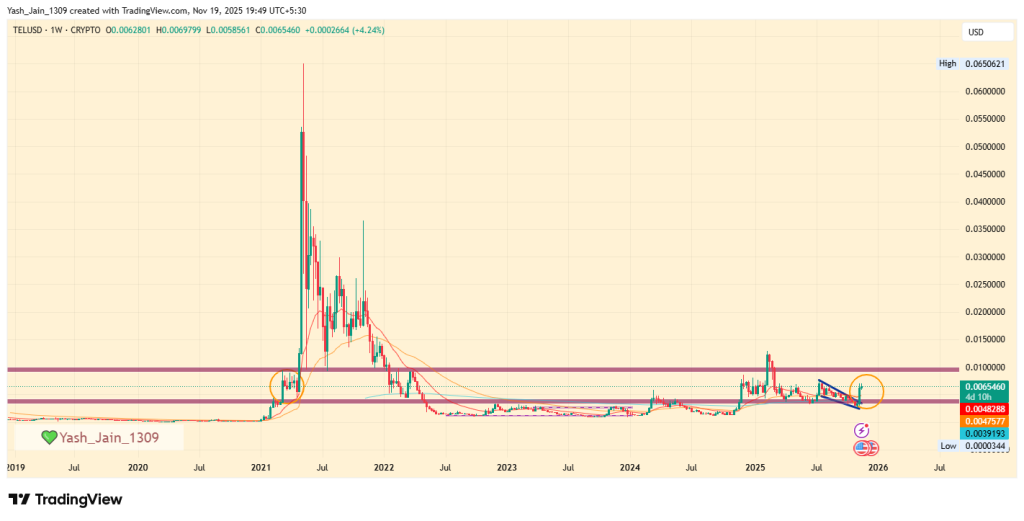This is the real truth behind the crypto crash that no one dares to talk about
Author: Inversion founder, crypto OG Santiago R Santos
Translation: BitpushNews
“To all LPs: We outperformed ETH, but the fund still lost 80%. We valued casino turnover as if it were recurring revenue. Thanks for participating.”
Everyone in the crypto market is watching these headlines:
-
ETFs are live.
-
Real companies are integrating stablecoins.
-
Regulators are becoming more friendly.
This is everything we once said we wanted.
So, why are prices still falling?
Why is bitcoin treading water or even giving up gains this year, while US stocks are up 15% to 20%?
Why are some of your favorite altcoins still underwater, even though “crypto is no longer a scam” has become mainstream consensus?
I want to talk about this issue in depth.
Adoption ≠ Number Go Up
Crypto Twitter has a deeply rooted assumption:
“Once institutions come in, once we get regulatory clarity, once JPMorgan launches a token... it’s over, we’re going to the moon.”
Well, they came. We saw the headlines. Yet, we’re stuck in place.
There’s only one real question in investing:
Is it already priced in?
This is always the hardest thing to know. But market behavior is telling us something uncomfortable:
We got everything we asked for—but it didn’t push prices higher.
Are markets inefficient? Of course.
Why? Because most crypto valuations are severely disconnected from reality.
$1.5 Trillion... For What?
Let’s zoom out.
Bitcoin is in a class of its own—it’s a perfect meme, like gold. Its market cap is about $1.9 trillion, while gold’s is about $29 trillion. Bitcoin is less than 10% of gold’s market cap. There’s a clean logic of hedge value + option value behind this.
Ethereum + Ripple + Solana + everything else adds about another $1.5 trillion in market cap, relying on far less solid narratives.
No serious person questions the potential of this technology anymore. Few would argue the whole thing is a scam. That stage is over.
But potential doesn’t answer the real question:
Is an industry with maybe only about 40 million active users really worth trillions of dollars?
Meanwhile, OpenAI is rumored to IPO at nearly $1 trillion, and its user base may be more than 20 times that of the entire crypto ecosystem.
Think about that.
Moments like this force us to face a real question:
From now on, what’s the best way to get crypto exposure?
Historically: infrastructure (infra). Early ETH, early SOL, early DeFi.
That trade worked.
Today? Most infrastructure is priced as if we’re guaranteed 100x usage and 100x fees. Prices are perfect, but there’s no margin of safety.
The Market Isn’t Dumb, Just Greedy
This cycle gave us all the headlines... but some truths have become clear:
-
The market doesn’t care about your story—it cares about the gap between price and fundamentals.
If that gap persists long enough, the market will eventually stop giving you the benefit of the doubt. Especially when you start showing real revenue.
-
Crypto is no longer the hottest trade. AI is.
Capital chases momentum. That’s how modern markets work. Right now, AI is the star. Crypto isn’t.
-
Companies follow business logic, not ideology.
Stripe launching Tempo (possibly referring to an internal or specific service) is a warning sign. Maybe, just maybe, companies won’t choose public infrastructure just because they heard on the Bankless podcast that Ethereum is the “world’s supercomputer.” They’ll only pick what’s best for themselves.
So I’m not shocked your holdings haven’t gone up just because Larry Fink realized crypto isn’t a scam.
When things are perfectly priced, one small move from Powell or a weird look from Jensen Huang can destroy the whole thesis.
Quick Math: ETH, SOL, and Why “Revenue” ≠ Profits
Let’s do a rough calculation for the major L1 chains.
First, staking—this isn’t profit:
-
Solana:
About 419 million SOL staked × ~6% ≈ 25 million SOL per year
At ~$140 → about $3.5 billion per year in “rewards”
-
Ethereum:
About 33.8 million ETH staked × ~4% ≈ 1.35 million ETH per year
At ~$3,100 → about $4.2 billion per year in “rewards”
Some people point to staking and say:
“Look, stakers get paid! That’s value capture!”
No. Staking rewards are not value capture.
They are token issuance, dilution, and security costs, not profits.
True economic value = user-paid fees + tips + MEV. This is the closest thing to “revenue” for blockchains.
In this regard:
-
Ethereum generated about $2.7 billion in transaction fees in 2024, leading all chains.
-
Solana has recently led in network revenue, bringing in hundreds of millions per quarter.
So, let’s roughly estimate the current situation:
-
Ethereum, with a ~$400 billion market cap, generates $1–2 billion per year in fees + MEV “revenue.” That’s a 200–400x price-to-sales (P/S) ratio, basically casino revenue at the cycle peak.
-
Solana, with a ~$75–80 billion market cap, has annualized revenue over $1 billion. That’s roughly a 20–60x P/S ratio, depending on how loosely you annualize (please don’t just pick peak months to annualize).
These numbers aren’t precise. They don’t need to be. We’re not filing with the SEC. We just want to see if we’re in the same galaxy.
And this doesn’t even touch the real issue:
The Real Issue: This Isn’t Recurring Revenue
These are not stable, enterprise-grade revenue streams.
They are super-cyclical, speculative, recurring flows:
-
Perpetual contracts (Perps)
-
Memecoins
-
Liquidations
-
MEV spikes
-
Degenerate churn
In bull markets, fees and MEV explode. In bear markets, they disappear.
This isn’t recurring SaaS revenue. This is a Las Vegas casino.
You can’t give a business that only makes money when the casino is packed every 3–4 years a Shopify-level multiple.
This is a different business. Different multiples.
Back to “Fundamentals”
In a normal world, the following would be unreasonable:
-
Ethereum, with a market cap over $400 billion, based on maybe only $1–2 billion in highly cyclical annual fees, is considered a “value” buy.
That’s a 200–400x P/S ratio, and growth is slowing, with L2s constantly leaking value. ETH doesn’t behave like a federal government with a tax system; it acts like a federal government but somehow only gets state-level tax revenue, while the real profits (L2s) are mostly captured by the states (L2s).
We hyped ETH as the “world computer,” but its cash flow story doesn’t match its price tag. Ethereum feels to me like watching Cisco’s huge energy: early leader, but wrong multiple, and may never see its all-time high again.
By comparison, Solana looks less crazy on a relative basis—not cheap, but not as absurd.
With a ~$75–80 billion market cap, it generates billions in annualized revenue—a stunning 20–40x P/S ratio.
Still high. Still inflated. But “relatively cheap” compared to ETH.
“To all LPs, we outperformed ETH—but the fund still lost 80%.”
Turns out, we priced casino turnover as if it were recurring software revenue. Thanks for participating :)
To give some context to these multiples:
The most admired growth stock on earth, Nvidia, has a P/E ratio (not P/S!) of 40–45x—and it has:
-
Real revenue
-
Real profits
-
Global enterprise demand
-
Recurring, contracted sales
-
And customers outside the crypto casino (fun fact: crypto miners were Nvidia’s first real super-growth wave)
Again: these blockchains’ revenue is based on cyclical casino income, not stable, predictable cash flow.
If anything, these chains should trade at a discounted multiple—not a premium to tech companies.
If the entire industry’s fees don’t shift from degenerate churn to real, recurring economic value, most valuations will have to be repriced.
We’re Early... But Not That Early
Sooner or later, prices will reconnect with fundamentals. We’re not there yet.
For now:
-
There’s no fundamental reason to pay high multiples for most tokens.
-
Once you strip out token issuance and airdrop farming, value capture for many networks disappears.
-
Most “profits” are tied to casino-style speculative activity.
We built rails to move money globally, cheaply, 24/7, instantly... and decided the best use case was slot machines.
Short-term greed; long-term laziness.
To quote Netflix co-founder Marc Randolph: “Culture isn’t what you say. It’s what you do.”
If your flagship product is a 10x leveraged perpetual contract on Fartcoin, don’t lecture me about decentralization.
We can do better.
This is the only way we graduate from an “over-financialized niche casino” to a real, long-term industry.
The End, and the Beginning
I don’t think this is the end of crypto. But I do think this is the “real beginning.”
We massively over-invested in infrastructure—over $100 billion poured into chains, bridges, L2s, infra projects—while severely under-investing in deployment, products, and actual users.
We’ve been bragging about:
-
Transactions per second (TPS)
-
Blockspace
-
Fancy rollup architectures
But users don’t care about these. They care about:
-
Is it cheaper?
-
Is it faster?
-
Is it easier?
-
Does it actually solve their problem?
Back to cash flow.
Back to unit economics.
Back to fundamentals: Who are the users, what problem are we solving?
Where the Real Upside Is
I’ve been long crypto for over a decade. That hasn’t changed.
I still believe:
-
Stablecoins will become the default payment rails.
-
Open, neutral infrastructure will power global finance behind the scenes.
-
Companies will use this technology because it makes economic sense, not for ideological reasons.
But I don’t think the biggest winners of the next decade will be today’s L1s or L2s.
Historically, the winners of every tech cycle have emerged at the user aggregation layer, not the infrastructure layer.
The internet made compute/storage cheap. Wealth flowed to Amazon, Google, Apple—those who used cheap infra to serve billions.
Crypto will rhyme with this:
-
Blockspace is a commodity.
-
The marginal benefit of infra upgrades is shrinking.
-
Users always pay for convenience.
-
User aggregators will capture most of the value.
The biggest opportunity now is embedding this technology into businesses that already have scale. Dismantle pre-internet financial infrastructure and replace it with crypto rails, because they really do lower costs and increase efficiency—just like the internet quietly upgraded everything from retail to industrial companies, because the economics were too good to ignore.
Everyone adopted the internet and software because it made economic sense. Crypto will be no different.
We can wait another decade for this to happen.
Or we can start now.
Update Your Assumptions
So, what does all this leave us with?
-
The technology works.
-
The potential is huge.
-
We’re still early in real adoption.
It’s worth re-evaluating everything:
-
Value networks based on real usage and fee quality, not ideology.
-
Not all fees are equal: recurring vs. one-off fees.
-
The winners of the last decade won’t dominate the next.
-
Stop treating token price as a scoreboard for tech validation.
We’re still so early that we act like token price tells us if the tech is working. No one chooses AWS over Azure because Amazon or Microsoft stock went up this week.
We can sit around for a decade waiting for companies to adopt it. Or we can start now.
Bring real GDP on-chain.
The revolution is not over.
Disclaimer: The content of this article solely reflects the author's opinion and does not represent the platform in any capacity. This article is not intended to serve as a reference for making investment decisions.
You may also like
Senate Eyes December Markup for Landmark Crypto Market Structure Bill

ZCash Price Rockets Past Resistance, Can ZEC Hold Above $616 And Hit $700 Soon?

Bitcoin ATMs Appear in Nairobi Malls, Regulators Warn No VASPs Are Licensed Yet
TEL Price Surges 160% in November as Multi-Year Pattern Signals Bullish Setup

